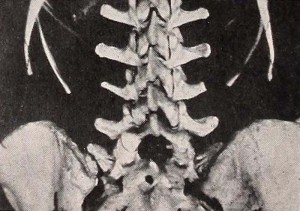
"Imagine, if you can, a subject which would be harder to present in motion pictures than the effects of a spinal anaesthetic. This is the problem that Leslie P. Thatcher solved so ably in his Technique and Principles of Spinal Anaesthesia with Nupercaine. Because most of the action takes place within the body, it was necessary to do some real thinking before a suitable motion picture presentation could be worked out. For example, the action of the fluid as it floats in the spinal canal was shown dramatically and effectively by floating some of the drug in a solution in a slowly tilting glass phial. A considerable use of X-rays served to show clearly just how the hypodermic needle should be handled, while well photographed diagrams and models aid the film's clarity. Operative scenes represent the best technique, and the action clearly demonstrates the qualities of Nupercaine as an anaesthetic. The picture is a study in straightforward exposition and, as such, it should serve its sponsors admirably. It is to be noted that Mr. Thatcher showed admirable restraint in his brief shots of operations. While sufficient for the medical man, they are not too long or gruesome for a lay audience." Movie Makers, Dec. 1939, 633-634.
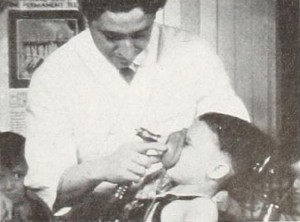
"Morton H. Read has made, in Teeth and Good Health, an effective study of the work accomplished by the Dental Clinic of the Public Schools of Springfield, Mass. This film should be of great interest to educators whose institutions offer a similar service to children of grade school age. The picture lucidly outlines the program followed by the teachers, nurses and doctors in the system set up by this school, to facilitate caring for the children's teeth. Charts and diagrams that warn the children of the danger of neglected teeth are shown, as well as excellent shots of the dentists at work. Thus, through familiarizing youngsters with the importance of dental care and its mechanics, the child is taught not to fear the dentist. A recalcitrant mother serves as a focal point for the detailed explanation of the advantages of the dental program in the school. The filming is marked by competent cinematography, logical sequence arrangement and simplification of detail." Movie Makers, Dec. 1942, 509-510.
"Telemark, filmed in the Swiss Alps by William G. McKelvy, ACL, is, as its name suggests, a skiing picture. However, it is more than that — it is also a very delightful and neatly plotted comedy that is the more convincing for being uncomplicated with the usual subsidiary plot and counter plot. Four or five youths who are expert skiers, one who is a novice, and a girl are at the beginning of a down mountain ski trail. The girl offers a kiss to the boy who can catch her. She tarts off, the able skiers follow hard on her trail, while the beginner stumbles and lags far behind. But the girl decides to trick her pursuers and hides on the way. The ending is obvious. The picture was exquisitely planned and sequenced for, as the camera follows the skiers down the mountain, there is complete smoothness in the shift of viewpoints. The action is made the occasion of splendid studies, as the boys on the run swerve and turn in stems, Christianias and Telemarks. Mr. McKelvy did not neglect to select charming compositions and to take full advantage of clear air and the contrast between the dark figures and trees and the white snow." Movie Makers, Dec. 1933, 500.
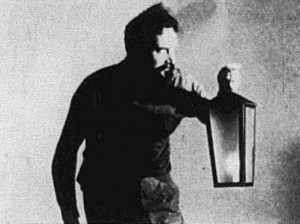
"In a setting of props prepared for the purpose and with the aid of makeup, Albert Bahcall has filmed the Tell-Tale Heart, adapted from the story by Edgar Allen Poe. The "old man" with a strong heart also has a protruding eye that annoys the manservant to a point beyond restraint. There is an effective use of color, moving feet and hands, and closeup of faces to sharpen the impact of the story" PSA Journal, Nov. 1957, 53.
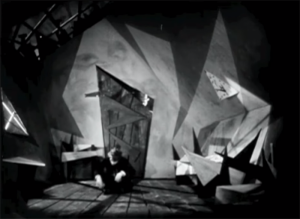
"The TellTale Heart is a 1928 American silent film directed by Charles F. Klein, based on the short story by E.A. Poe. This experimental, avant-garde film used many new techniques and influenced a series of cinematic Poe renditions in both the United States and France, including The Fall of the House of Usher by M. Webber, made in the same year. The two films have many aesthetic similarities, although the narrative in The TellTale Heart is significantly less abstract. The music underscoring the work creates a parallel drama to the events unfolding on the screen. After the title sequence, some of the text from the original short story is projected to foreshadow the gruesome events to follow. A still of the Old Man's eye is layered on the top of this scrolling text, accompanied by the first statement of the “Vulture Eye Chord”, which continues to come back as a leitmotif throughout the score. Also prominent is the leitmotif for our narrator, which takes the shape of a disturbingly quick and easily unhinged "Death Waltz". Upon strangling the Old Man for his vulture eye, the waltz quickly dissolves into a quick 5/8 section, dignifying the beating of a heart, which gradually slows. After two detectives come to investigate the scene, the narrator having initially been successful in covering up his deceit, the underscoring reveals to us that he's been tortured by his deeds as the two leitmotifs emerge from an otherwise calm texture. After hearing the beating of the Old Man's heart beneath the floorboards, the narrator admits to his sin and reveals the body at the end of the film" Center for Fiction, NY.
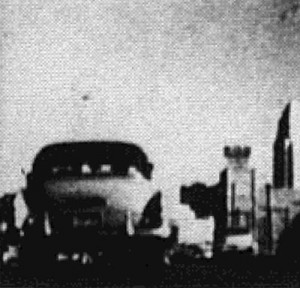
"A fast ride through the mountains, over the desert, and on to the freeways to the accompaniment of a superb sound track. An audio-visual experiment designed to elicit a response from the audience. You cannot help but become a part of the "tempo" PSA Journal, Oct. 1963, 42.
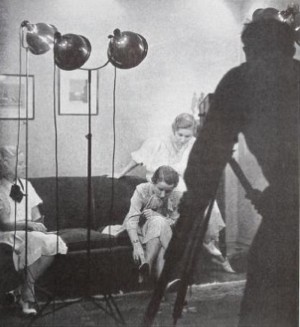
"In Chicago, the Cinema Players have recently completed a one reel, 16mm. comedy, Ten Easy Lessons, the first major production from this new group. The story was directed and photographed by George W. Colburn, ACL, and presents in leading roles Jules Brunner, Louise Byrne, Rudolf Heinkel, DeEtta Kenny, Greta Brunner, Charles Byrne, Evelyn Heinkel and Evelyn Colburn." Movie Makers, Nov. 1935, 476.
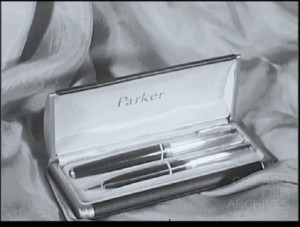
"Short documentary about fountain pen repairs and the process of repairs within a fountain pen hospital. The film begins with a client handing over his pen to the receptionist. From there the pen goes to Robert "Doc" Davis, who performs a nine point check-up on the pen. This is followed by exploded views of various pen models, including the Schaeffer Triumph, Parker 51 and the Eversharp Skyline. Last, the film shows how gold lettering is used on both pends and leather goods. Outtake scenes of the pen hospital and its employees follows the film." Chicago Film Archives.
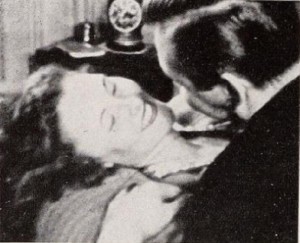
"Novel continuity, beautiful cinematography and a nosegay of feminine charms are the distinctive features of Ten Pretty Girls, produced by Anchor O. Jensen. This expert little drama, made on 8mm Kodachrome, is an excellent example of quality workmanship in that width. The opening scene shows a young man contemplating his address book. He folds a large piece of paper and cuts from it a string of ten dolls, which become the symbols of as many lovely young women. As each doll is torn from the group, a new sequence featuring one of the girls is introduced. A different flower, corsage or bouquet figures in the action as each of the girls is shown in some individual and flattering setting. At the conclusion, the young man has made his choice; he spurns the blondes and brunettes for the favors of a titian beauty." Movie Makers, Dec. 1943, 474.
"Okamoto's heroine was a Japanese girl making a doll as a birthday present for a friend. Pictorial values, backgrounds of the Japanese countryside in spring, and the delicate grain which Cinematographer Okamoto had achieved gave his film distinction." American Cinematographer, Feb. 1935, 78.
"'Tender Friendship,' in 150 feet of 8mm film, was sensational from the photographic standpoint. Its sheer beauty, its poetic rhythm both in story and photography, made it one of the outstanding pictures of the contest" American Cinematographer, Dec. 1934, 365.
Total Pages: 203